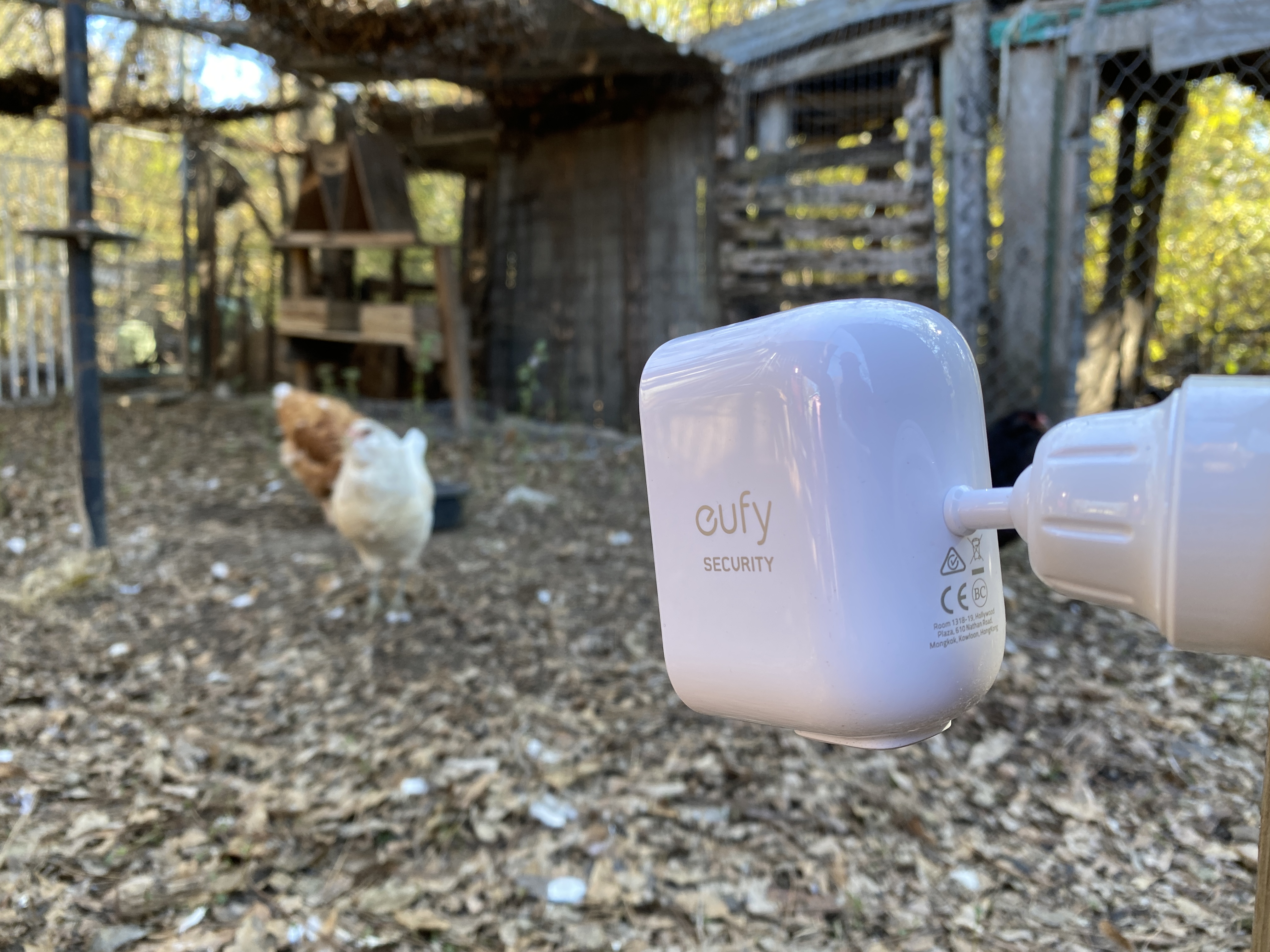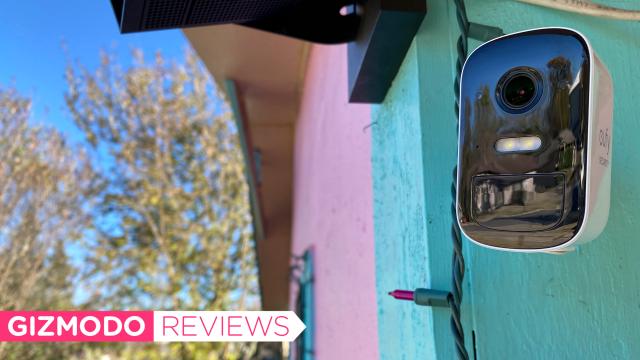I don’t know about you, but I’d like to be able to walk around my neighbourhood with my kid without concern that my neighbour’s camera is disseminating video of it to anyone who wants it in the area. As the owner of a camera, I don’t really want it to serve as an anchor for data scraping companies who make their money via the commodification of my personal information. Enter the EufyCam 2C Pro, a security camera from Anker that works with HomeKit to lock down all the footage it grabs.
The updated version of Anker’s HD HomeKit Secure Video-compatible camera, the 2C Pro records 2K video, has 6-month battery life, and employs on-device AI to detect people and…whether they’re crying? I couldn’t get the cry detection to work by faking it, and while I thought about watching the intro to Up to make the tears happen, I can’t handle that right now. The 2-pack I tested came with the bridge, called Home Base 2, and two cameras and retails for $US320 ($426). The bridge looks a little like a smaller, tapered Airport Time Capsule, with the cameras encased in a glossy white plastic, and they are Definitely Cameras, so if you wanted them to be sneaky, they aren’t that.
There is also a mount, comprised of four pieces: a base that you screw into the wall, then bits that clip into the mount and hold the ball-jointed, articulating arm, which itself has a little screw tip that you affix the camera to. This is a nice convenience, but hot damn you could just take it right off the wall if you wanted to steal it. I don’t know how many people are out there stealing security cameras, but things happen!

EufyCam 2C Pro
What is it?
Anker's Eufy-branded security cameras that support HomeKit Secure Video and local storage.
Price
$US320 ($426) for two cameras and a hub
Like
It's easy to set up, with solid functionality, and welcomed HSV-support.
No Like
I had to hunt down a firmware update for the best HSV support. 2K is only available with the Eufy app and not noticeably better than 1080p
The Eufy website pushes privacy as one of its biggest selling points, which was the primary reason I wanted to look at it. It’s no secret that we’re not enthusiastic around here about Ring cameras because of it Orwellian approach to surveillance (talk amongst yourselves), and I am not willing to buy a camera that doesn’t offer local storage, a reasonable, encrypted alternative, and some assurances that the videos it captures are not used or accessed without my consent.
In evaluating Anker’s privacy claims, the most important thing for me was its compatibility with HomeKit Secure Video, which is Apple’s security camera platform that allows for 10 days’ worth of end-to-end encrypted cloud storage, requiring no additional subscription fees beyond those paid for in a 200 GB or 2 TB iCloud storage plan. Heavy bonus points if I can use the camera without ever downloading the manufacturer’s app. So, how did the eufyCam 2C Pro do?
I give it a B. Setup is easy, though it involves a startling ladybot voice that yells at you, so I advise against setting it up while people are sleeping. While I was able to complete the setup exclusively using the iOS Home app, the clips the cameras captured were never longer than 5 seconds long, if they were recorded at all. Motion detection was iffy, working about 50% of the time. I did some quick Ask Jeeves-ing, and it turns out this is a common issue, resolved by e-mailing Eufy support to request a non-public firmware update I’d read about. Eufy responded overnight, saying it’d push the update, and lo, I awoke the next morning to the magic of Firmware Festivus, and a working HomeKit Secure Video integration!

If you are unclear on HomeKit Secure Video, you’re not alone! Apple’s support doc is pretty light on detail, but here is some stuff to remember: Recordings max out at 1080p, your videos do not count against your total iCloud storage, and they’re accessible within the camera pane in the Home app. Additionally, all processing of motion detection occurs on your chosen Home Hub – in my case, a HomePod – and Apple says it’s unable to break the encryption of your videos, so, theoretically, you and those you allow should be the only ones able to view them. Facial recognition, also processed locally, uses your chosen iCloud photo library as the reference point, too, which seems to work about as well as these things do. If you have a HomeKit Secure router, you can limit the camera’s connection to your local network, and apart from the Home Base 2’s friendly blue status ring turning to an angry red, it doesn’t seem to complain about it that limitation. Though you do lose the Eufy app’s functionality.
Nice as HSV is, though, iCloud’s gonna iCloud, which means that loading the videos can be sluggish, regardless of your internet speed. There is also no good way to batch download videos from iCloud, so you have to go through the same process of tapping the share icon, then “next”, then choosing where to save the video, for each and every one.
You can get automatic local storage (up to 16 GB) by concurrently using the Eufy Security app, but this hits your camera’s batteries hard. It wasn’t clear to me why until I looked in the Eufy app and found that it had been recording at least one video about every 3-to-5 minutes, regardless of what was happening over in the Home app. Turns out, if you use HSV, Eufy’s default is to set to record all motions, so I almost might as well have been livestreaming from it.
In fact, after only four days of use with HomeKit, both cameras’ charge fell below 50%. The batteries are not user-replaceable, so I’ve seen some concern about the batteries’ overall life, but given they’re the same cells used in e-cigarettes – that is, batteries that tend to take a beating and go through hundreds of charge cycles in the time these will go through two or three — I’m not concerned about that.
I also used the cameras for a time without HSV, and it is actually a pretty nice experience! The Eufy app is fairly easy to use, and viewing videos is quick, thanks to local storage on the Home Base 2. They even loaded fast outside of my home network, trouncing iCloud.
In settings, you’ll find options for NAS storage (using the Real-Time Streaming Protocol, which traditional IP camera users will be familiar with), customising recording length, choosing whether to timestamp your video or not, disabling the status LED on the camera, and adjusting motion sensitivity. NAS storage set-up aside, It’s all pretty easy to get around and understand, which is, of course, never a given with these things.
Oh, and it has a siren, in case you want to make boom boom in your pantaloons every time you forget about it and stand in the camera’s line of sight a little too long. It’s not the worst sound, but it’s definitely alarming, so make sure you set up geofencing so it only works when you’re away, then customise the length of time the camera waits before it starts Chicken Little-ing every time a spider crawls across the lens. Personally, I’ll never use it, because I know that thing is just going to yell at the same bush or tree every day, and my neighbours will be too nice to say anything about it, but will privately resent me forever.
Now, you’ll notice I haven’t yet mentioned the flood light or 2-way audio. That’s because I couldn’t test them until I was using the Eufy’s app — neither has been made available in the Home app. Worth noting also is that, since HomeKit Secure Video only supports 1080p, you will be unable to access full 2K video unless you’re exclusively using Eufy’s app.
Let’s talk about that 2K resolution. Right next to the eufyCam 2C Pro, I have a Netatmo Presence. One of the first cameras to promise (yet-to-be-delivered) HSV support, the Netatmo maxes out at 1080p. Comparing the two, I noticed more realistic colours and better exposure control with the Eufy — images taken on it tended not to be all blown out. However, even at 2304 x 1296, the eufyCam 2C Pro initially lacks much of the detail of the Netatmo, the former only gradually resolving to more detail than the latter after my wife’s car had moved mostly out of frame in the shots below. It looked good once it got there, but the eufyCam’s slow ramp-up to full resolution ended up being the difference between reading a licence plate number or not, which is a pretty important disclaimer. That said, eufyCam’s night vision was significantly better than on the Netatmo, seeing much farther, with quite a bit more detail. It was just silly how much better it was.
No smart home security camera, as far as I can tell, comes without some compromise, but for what it does, and how it does it, the eufyCam 2C Pro is a very solid product. It offers a largely foolproof setup and installation, as well as good-looking video (for a security camera) and overall consistent functionality. It’s easy to use in a way that largely respects your privacy, too, making this a pretty good camera for anyone concerned about such things. The biggest caveat I can come up with is that the 2K resolution just doesn’t look all that much better than standard HD, which doesn’t help it justify that $US100+ ($133)+ premium.
README
- Homekit support is welcome and it works well…once you get a firmware update.
- 2K resolution is supported but only in the Eufy app.
- There’s a lot to love about the EufyCam 2C Pro, but the need to use both the Homekit and the Eufy app is annoying and battery draining.
